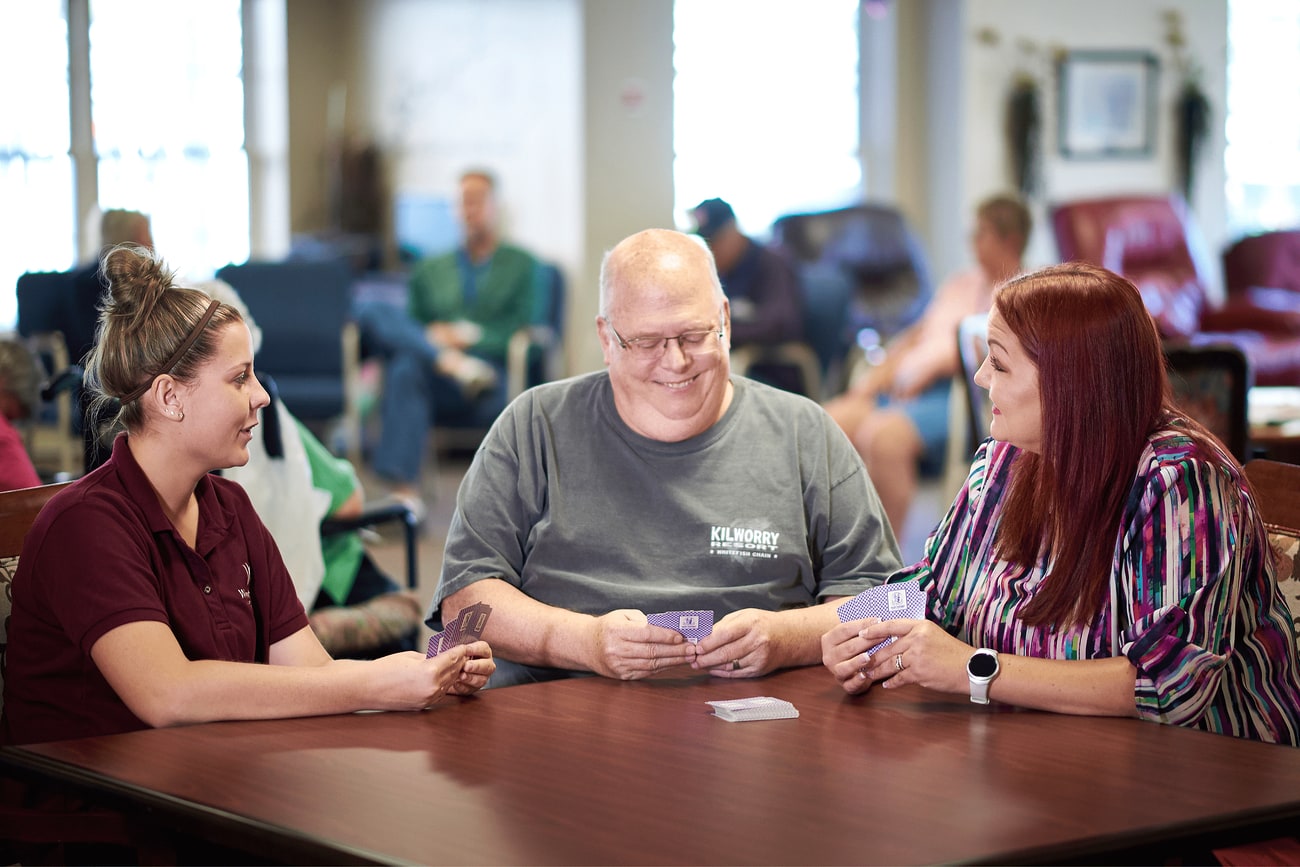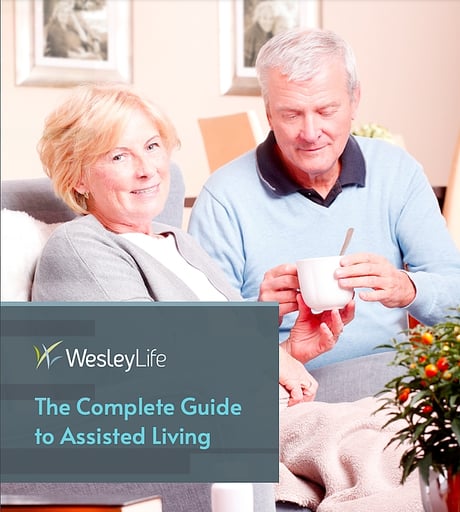The Complete Guide to Assisted Living

Introduction
Senior assisted living allows older adults to remain independent and empowered while receiving the support they need. At WesleyLife Communities for Healthy Living, assisted living residents are a part of thriving communities that encompass multiple levels of living. You will live an engaged, independent, comfortable life and have access to assistance if you need it.
Are you or your loved one considering assisted living? This guide will dispel myths about assisted living, detail the benefits, and help you determine when it’s time to make the move.
Download a PDF version of this guide by filling out this form, or keep scrolling to read.

What Is Assisted Living?
Common Misconceptions About Assisted Living
When to Make the Move to Assisted Living
Finding the Right Assisted Living Situation
Find Senior Assisted Living at a WesleyLife Community

What Is Assisted Living?
Assisted living is essentially independent living with support available as needed and desired. Across the country, more than 800,000 Americans in 28,900 communities take advantage of this level of living. Assisted living provides a solution for older adults who want to live as independently as possible while enjoying services and amenities, living in private houses or apartments, and accessing assistance — either occasionally or on a daily basis.
In our vibrant WesleyLife Communities for Healthy Living, “care” might look different from resident to resident. For some, it might mean that a friendly face checks in on them occasionally. For others, it might mean medication management or assistance with activities of daily living.
Ultimately, assisted living is tailored to your needs, and you can enjoy the same amenities and programming as independent living residents. Amenities differ in each of our Communities for Healthy Living, but common amenities include fitness centers, walking paths, fine dining, general stores, and banking.

Common Misconceptions About Assisted Living
Misconceptions persist about what assisted living is and isn’t. In reality, it is the perfect way to live independently while having access to assistance as needed and desired.
Here are some common misconceptions you may have heard about assisted living:
1. Living in assisted living means living in a nursing home.
Not true. What some may think of as “nursing homes” are long-term care centers. Typically, people who require long-term care need around-the-clock support from medical professionals. In assisted living, you can lead the life you want while receiving the support you need.
2. Residents in assisted living don’t set their schedules.
Quite the opposite! You eat when you want, visit with friends and family when it suits you, spend time how you want, participate in community programming, and take vacations whenever you desire. You will be living in your home, doing things on your own time.
3. Assisted living is too expensive.
When considering medical history, the potential for unforeseen needs, and the costs of at-home care, living at home can cost more in the long run. According to Genworth Financial’s 2021 Cost of Care Survey, the median monthly cost for assisted living in the U.S. is $4,500. Compare this to at-home service costs, which range from $30-$50 an hour.
The monthly fee for this level of living at WesleyLife covers access to amenities throughout campus, including meals, caregiver assistance, and various programs and services. Not only do these amenities exceed those provided by at-home services, but they also emphasize that assisted living in a WesleyLife Community for Healthy Living is about much more than assistance — it’s about living life to its fullest potential.
4. Residents aren’t allowed to leave campus.
Assisted living is as much about providing support as it is about maximizing your freedom and encouraging you to live your best life. Most of our assisted living residents continue to drive their own vehicles. However, if you don’t own a vehicle or prefer not to drive, many of our communities have dedicated vehicles for regular trips to grocery stores, pharmacies, churches, restaurants, and cultural events.
5. There’s no privacy.
In reality, your living situation in a WesleyLife Community for Healthy Living looks like living in a house or an apartment. In other words, you choose when you have visitors, and no one enters your space without your knowledge and consent. Plus, caregivers provide support based on your routines, ensuring your privacy is respected.
6. All recreational activities will be planned for me.
Although Assisted living provides engaging programming, nothing is mandatory. You have the freedom to take part in programs that interest you. Continue to pursue your passions with no interruption as you transition from your current living arrangements to a WesleyLife Community for Healthy Living.
7. Food options are limited.
Our communities offer tasty, healthy options for breakfast, lunch, dinner, and snacks! You will have access to a range of restaurants, from fine-dining experiences to bistros for a casual bite to eat.

When to Make the Move to Assisted Living
If you’re still unsure about whether assisted living is the right choice for you or your loved one, consider a few signs that could signal that it’s the right time to transition to assisted living:
- Chronic health problems, such as hypertension, high cholesterol, arthritis, or diabetes.
- Signs of dementia, including a loss of motivation, behavior changes, and struggles with concentration.
- Mobility issues, such as joint problems, muscle weakness, and pain.
- Medication delays or forgetfulness.
- Difficulty with daily activities, such as dressing, bathing, grooming, eating, walking, or getting in and out of bed.
- Signs of sadness and loneliness, which could be alleviated by community living and easy access to events and travel.
- A change in eating habits, such as eating too little or too much.
Not sure how to start your decision-making process? Consider taking this 4-5 minute senior living assessment to determine if assisted living is the right choice for you or someone you love.

Finding the Right Assisted Living Situation
When you have decided that assisted living is right for you, the next step is to find the right community. Depending on where you live, you might have several options. As you start ranking your options, consider the following factors:
- Affordability: Before touring a community, decide on a comfortable budget by working with a financial planner or using an assisted living cost calculator.
- Reviews: Online reviews can help you or your loved one narrow down options, providing helpful accounts of life in the community.
- Caregivers and current residents: If the opportunity is available, tour the community. This will give you the chance to speak with current residents about their experiences and see if caregivers meet your expectations.
- Quality of food: On the same tour, stay for a meal. Ask how often the menu changes and if dietary preferences and restrictions are respected.
- Distance from loved ones: Assisted living doesn’t mean your life needs to significantly change. Find a community that’s close to loved ones and your local community.
- Levels of living: Consider your current and future needs by selecting a community that provides multiple levels of living, such as memory support, long-term care, and short-term rehabilitation.

Find Senior Assisted Living at a WesleyLife Community
Assisted living means having access to assistance when you need it while living an independent, engaging life. WesleyLife’s Communities for Healthy Living offer comfort and safety with a promise of a life that emphasizes choice, dignity, and guidance.
So what do you say? Ready to find the right community for you? Explore WesleyLife’s beautiful locations to discover your perfect fit.
Download a PDF version of this guide by filling out this form.

.jpg?width=450&length=450&name=WesleyLife%20Image%20(5).jpg)
.jpg?width=450&length=450&name=WesleyLife%20Image%20(3).jpg)




.png?width=450&length=450&name=Untitled%20design%20(85).png)


